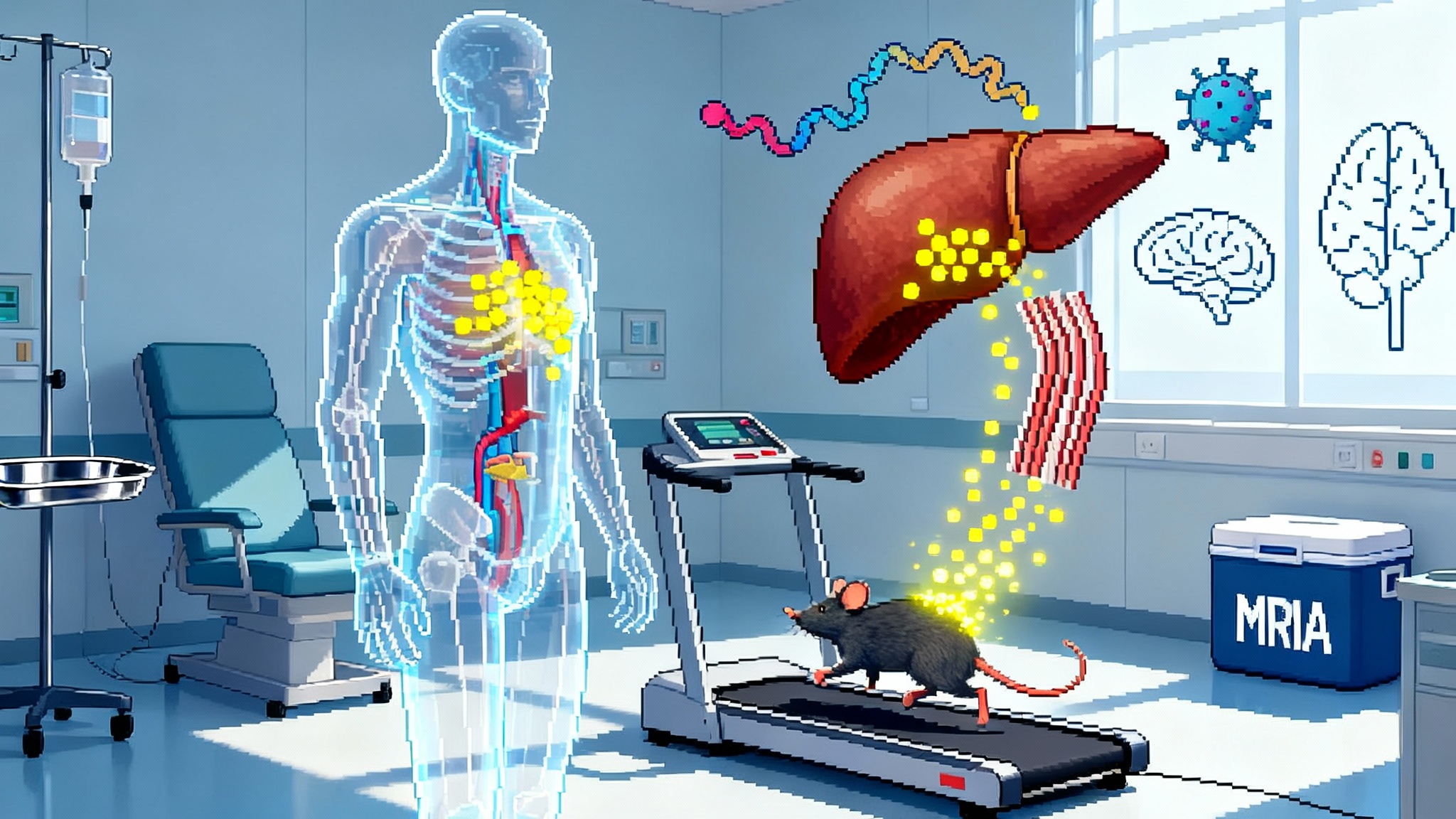Lp(a) Goes Mainstream: A Single Shot That Lasts a Year
A March 2025 NEJM trial reported that a single lepodisiran injection cut lipoprotein(a) by about 94 percent for most of a year. With pelacarsen outcomes now expected in early 2026, Lp(a) is shifting from genetic liability to actionable target.

Breaking through the last untouchable cholesterol
For decades cardiology had an awkward blind spot. Patients with spotless low density lipoprotein cholesterol could still suffer heart attacks and strokes. Their scans showed plaque, their arteries scarred, yet their low density lipoprotein looked perfect. A hidden culprit kept popping up in genetic studies and family trees: lipoprotein(a), often shortened to Lp(a).
In March 2025, a clinical trial landed that made Lp(a) feel suddenly druggable and practical. In the New England Journal of Medicine, investigators reported that a single injection of lepodisiran, a small interfering ribonucleic acid that silences the LPA gene in the liver, lowered Lp(a) by roughly 94 percent at the highest dose and kept it low for most of a year. The result was presented at the American College of Cardiology and published as the NEJM lepodisiran study.
Beyond the number, the shape of the curve is what grabbed cardiologists. This was not a fleeting dip. The reduction was deep and long, with levels still far below baseline many months after one shot. The long tail hints at dosing intervals that look more like a vaccine visit than a chronic medication cycle.
Lp(a) in plain language
What is Lp(a), and why has it been so stubborn? Think of the familiar low density lipoprotein particle as a cargo ship hauling cholesterol. Lp(a) is that same ship but with a special hook on the stern, a protein called apolipoprotein(a). That hook is built from repeated loops known as kringles. The more loops, the stickier and more troublesome the particle becomes. The hook also looks a lot like plasminogen, a protein that influences clotting, which is one reason Lp(a) is tied to both plaque buildup and thrombosis.
Your Lp(a) level is set mostly by the LPA gene you inherit. Diet and exercise can transform low density lipoprotein and triglycerides. They barely nudge Lp(a). That is why Lp(a) drives what doctors call residual risk. Even with textbook low density lipoprotein levels on statins, ezetimibe, or proprotein convertase subtilisin kexin type 9 inhibitors, people with very high Lp(a) can keep accumulating atherosclerosis and face higher rates of heart attack, stroke, and aortic valve disease.
Clinicians measure Lp(a) in either milligrams per deciliter or the more precise nanomoles per liter. The conversion is not one to one because particle size varies. Many labs flag risk starting around 50 milligrams per deciliter, which is roughly 125 nanomoles per liter for a typical particle. About one in five people worldwide sits above that threshold. The number is fairly stable from childhood onward, which is why a single test per lifetime can be so informative.
Why lepodisiran looks different
Lepodisiran belongs to a class of medicines that do not block a protein after it is made. They intercept the blueprint. Small interfering ribonucleic acids are short strands that home to liver cells and guide a molecular eraser to the messenger ribonucleic acid that carries instructions to build apolipoprotein(a). No blueprint, no hook, fewer dangerous particles.
Two features of this approach stand out for real world prevention:
- Infrequent dosing: In the trial, one injection gave nearly a year of suppression in many participants. With program optimization, twice yearly dosing looks plausible. That is a schedule people can stick to.
- Deep lowering: A ninety plus percent drop can push many patients below risk thresholds, even if they start in the highest tiers.
If you are picturing an add on to the rest of lipid care, you are on the right track. Lp(a) drugs will not replace statins or diet. They fill a different gap. They remove the hook on the ship that low density lipoprotein therapies do not touch.
Antisense versus small interfering ribonucleic acid
Lepodisiran is not alone. Pelacarsen, an antisense oligonucleotide from Novartis and Ionis, binds to the same messenger ribonucleic acid but with a slightly different chemistry. Antisense drugs are single strands that recruit enzymes to chop up a target message. Small interfering ribonucleic acids are double strands that tap into a natural silencing pathway. Both are delivered to the liver using a sugar tag that acts like a postal code for hepatocytes.
Dosing may be the practical differentiator. Today’s data suggest pelacarsen will be a monthly injection, while siRNA candidates aim for every six months or longer. The right answer will depend on outcomes, safety, and adherence. A monthly shot is easy to remember. A twice yearly visit fits primary prevention clinics.
The outcomes test is next
Lowering a number is only step one. Regulators and payers will want proof that cutting Lp(a) reduces heart attacks, strokes, and cardiovascular deaths. That is what the HORIZON outcomes trial with pelacarsen is designed to test. The original guidance pointed to a 2025 readout. In January 2025, Ionis noted that Novartis updated the timeline, with topline data now expected in the first half of 2026. See the Ionis update on HORIZON timing.
That means lepodisiran arrives into a landscape that is likely to be defined first by pelacarsen outcomes data. If HORIZON shows a clear reduction in major adverse events, it will validate the biology clinicians have believed for years and pave the way for a class.
Safety, signals, and what will move the needle
Safety so far looks encouraging. In mid stage studies of lepodisiran, serious adverse events were not attributed to the drug, and injection site reactions were generally mild. Pelacarsen earlier trials showed a similar pattern, with local reactions as the most common issue. That said, dose, duration, and the breadth of the treated population can change the picture. The field will watch for liver signals, immune effects, and any hint that very deep and very long Lp(a) suppression has unforeseen consequences.
How much lowering is enough is another practical question. Genetic studies suggest that the higher you start, the more lowering you need to materially reduce risk. If outcomes trials reveal a threshold effect, clinicians could target absolute Lp(a) levels rather than percentage changes. That would simplify treatment decisions and payer policies.
The case for universal Lp(a) screening
If a medicine given once or twice a year can turn a hard genetic risk into a manageable factor, the obvious next move is to find the people at risk early. Several professional societies have been moving toward at least one lifetime Lp(a) measurement in adults, with earlier testing in families where premature heart disease clusters. The logic is simple:
- Lp(a) is mostly genetic and stable. You do not need to repeat the test often.
- The result meaningfully changes prevention planning. A high Lp(a) nudges you toward more aggressive low density lipoprotein goals, aspirin decisions in select cases, and earlier attention to blood pressure and diabetes.
- With new therapies, that number could now point to an actionable path rather than a shrug.
For health systems, a one time Lp(a) test fits well into existing preventive blood panels. The cost is modest compared to imaging or genetic testing and the result is actionable for decades.
Payer coverage will hinge on four specifics
Payers have clear levers they use when a new class arrives. Expect the following to shape access in the United States:
-
Outcomes data: If HORIZON shows a reduction in events, coverage for patients with established cardiovascular disease and elevated Lp(a) will come first. If the magnitude is large and safety is clean, that coverage could be broad.
-
Risk thresholds: Insurers will likely peg eligibility to absolute levels, for example 125 nanomoles per liter or higher, and may require confirmation on a standardized assay. Some may also prioritize people with events despite optimal low density lipoprotein control.
-
Dosing logistics: Twice yearly siRNA is attractive for adherence and administration through specialty pharmacies or infusion centers. Monthly antisense might be easier for retail distribution if self injection becomes an option. The site of care will influence total costs.
-
First event prevention: If outcomes data are strong and safety is reassuring, the conversation will quickly shift to people who have not had a heart attack or stroke but carry very high Lp(a). That is where the healthspan argument is strongest and where prior authorization criteria will matter most.
What to watch next
- HORIZON topline in 2026: The big pivot from surrogate to hard outcomes.
- Durability data: Longer follow up on lepodisiran and other siRNA agents to confirm that annual or twice yearly dosing is enough in typical clinics.
- Assay standardization: Converting between milligrams per deciliter and nanomoles per liter is messy. Expect a push to harmonize reporting so clinicians and payers speak the same language.
- Aortic valve disease signals: Lp(a) is tied to calcific aortic stenosis. Trials will probe whether lowering changes valve progression, not just artery events.
- Real world adherence: Infrequent dosing should shine, particularly for younger patients who do not feel sick but carry high genetic risk.
An accelerationist playbook to bend the curve
Lp(a) lowering does not live in a vacuum. It arrives into a prevention toolkit that is upgrading fast.
- Stackable genetics: Base editing of low density lipoprotein pathways is advancing, with programs like the one-and-done LDL therapy update pointing to durable background control of low density lipoprotein.
- Inflammation and clonal risk: Targeting age related hematopoiesis sits alongside lipid control. See how colchicine for TET2 blood clones could complement lipid strategies.
- Metabolic levers: Weight, insulin sensitivity, and liver fat shape cardiovascular risk. The Semaglutide 2025 clock signal frames where metabolic therapies might fit a broader prevention plan.
- Early life triage: Because Lp(a) is stable from childhood, pediatric or young adult screening in families with early cardiovascular disease could identify the ten percent who benefit most from aggressive prevention long before the first plaque forms.
- Imaging feedback loops: Coronary calcium scanning in midlife is a useful decision aid. In high Lp(a) carriers with zero calcium, the plan might be watchful waiting with diet, exercise, and statins. In those with rising calcium despite low density lipoprotein control, early Lp(a) therapy could be the lever that changes slope.
How to act now
- Ask for an Lp(a) test once. If you have a family history of premature cardiovascular disease or aortic valve disease, ask sooner.
- Get low density lipoprotein to goal with proven therapies. Lp(a) is additive to, not a substitute for, low density lipoprotein management.
- If your Lp(a) is very high, discuss trial options. Large outcomes studies are enrolling or preparing for follow up, and access to therapies after approval will likely prioritize those at highest risk.
- If you run a clinic or health system, plan for screening pathways and referral logic now. Build electronic health record prompts for one time Lp(a) testing and define thresholds that trigger a prevention visit.
The bottom line
Lepodisiran data made Lp(a) feel manageable in a way that once seemed out of reach. A single shot that knocks down a stubborn, inherited risk by about ninety four percent for most of a year is not a tweak. It is a new handle on cardiovascular aging. The final verdict will come from outcomes data, and the first big readout is now expected in 2026. If that is positive, infrequent dosing will let prevention move earlier, to first event and even pre event planning, with a chance to stack therapies that change the long arc of risk. The invisible hook on the cholesterol ship may finally be one we can unclip and keep off.








